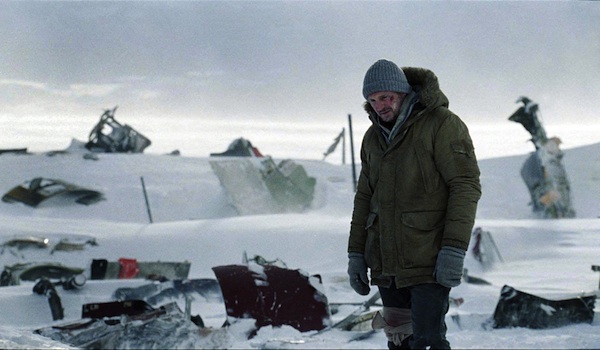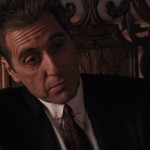The Grey Review
Posted on February 7, 2012 By John Gilpatrick 2012, Movie Reviews, New Releases
Joe Carnahan has gotten a reputation for directing B-level action flicks—The A-Team, Smokin’ Aces. But The Grey is a whole other animal. “Action” isn’t exactly a word I’d use to describe it, though there is a big crash sequence and a few wolf-fighting scenes. It’s actually more a mix of a man vs. nature tale and a meditative drama about life and death. It’s like Hemingway meets Bergman but with Liam Neeson at his most badass. All kidding aside, however, The Grey is the best January film I can remember. It also has a legitimate shot at my end-of-year top 10 list. Bizarre, I know, but it’s just really damn good.
John Ottway (Neeson) is one of many members of an oil-drilling outfit heading deep into Alaska’s wilderness for a job. Tragically, their flight there crashes, leaving all but seven men dead by morning. Ottway, whose job entails protecting the others from Alaska’s natural predators, takes a leadership role, organizing the others and doling out the tasks that are most essential for their survival. When they realize that the cold and lack of food aren’t the only things to worry about—that’s to say they find out they are unwitting trespassers on a wild wolf colony—Ottway’s knowledge and skills become even more essential. But to survive, they need more than just this one man. They need each other, and they need to find something inside them that will both vanquish fear and help them overcome the seemingly insurmountable odds against them.
As a piece of genre filmmaking, The Grey is well-choreographed and suspenseful, but a little familiar. With seven men (some of whom aren’t very developed at all) in such an extreme setting, it’s inevitable that a few will be knocked off throughout the film. Carnahan does surprise you with at least one of the deaths—not necessarily opting to kill the most anonymous character every time. But with so many interesting scenes and shots and conversations in the this film, the idea that we have to play your standard horror-movie version of musical chairs is a little disappointing.
Thankfully, the negativity ends there. With so many virtues to extoll, it’s hard to know where to start. How about with the film’s MVP—Carnahan. Here’s a director I’ve never really gotten the appeal of. Though he’s made a few bombs in recent years, he still has his fair share of loyalists from his earlier films like Narc—another film I don’t really care for. Wherever you fall on Carnahan, however, only a fool would call him untalented after seeing this film. Besides crafting a gripping story that’s told in a way that should satisfy both the mainstream moviegoer and your average art-house Joe, the sense of place, set pieces, dialogue, and shot selection all satisfy completely.
If Carnahan is the film’s MVP, Neeson isn’t far back in the running. This is the best performance he’s given in many years. It calls upon him to appear physically imposing, though his character will be the first one to admit he’s scared shitless by his predicament. Before the crash, he apparently went through some kind of relationship turmoil, which actually made him want to end his own life. But his later perseverance is credited greatly to this relationship, as well as a surprisingly effective poem written by his late father. These two things give him the strength he needs to draw on when he feels like God has abandoned him. One of the film’s most powerful moments occurs when he cries out—no, begs—God for a sign that things might possibly get better. He’s met, appropriately enough, with a wolf’s snarl. That’s the kind of bleakness presented in The Grey. That’s the kind of physically and emotionally draining performance Neeson gives.
The supporting cast is made up mostly of unknowns, though Dermot Mulroney is on-hand as one of the quieter men in Ottway’s party. He’s actually good, albeit unrecognizable, as Talget—the man tasked with carrying the wallets of all the deceased. Frank Grillo plays Diaz, the token asshole in the group. He challenges Ottway’s leadership from the outset, though his first face-to-face with a wolf shuts him up quickly. His arc feels predictable at first, though it grows richer the longer he’s around.
The way The Grey discusses faith is also noteworthy. It certainly could have been cliche, especially in a film with a number of deaths. But Carnahan opts to not throw us a token evangelical who insists God will keep him safe only to die the film’s most painful death. I sort of thought The Grey would go that route at some point, but it really doesn’t. All the film’s speeches and conversations—including Ottway’s father’s poem, which is just a perfect touch—feel authentic, adult, and definitely serve the tone well.
I wonder what would have happened if this film was released a month earlier. In a December that was, by and large, filled with minor disappointments, could The Grey have been a sleeper hit and a potential Oscar play? Maybe. But with a late January release, it can kiss any lofty expectations like that goodbye. Still, Carnahan and company should be proud of this film. It’s a terrific technical achievement from beginning to end (the plane crash is absolutely exhilarating), and it manages to reach a level of dramatic maturity that most films of any genre rarely even strive for. January is typically a dumping ground, but 2012 certainly set a new mark for quality. And if the rest of the year’s titles can live up to or come close to The Grey, it’ll be a pretty special 12 months.
2012, 3.5 Stars, Dallas Roberts, Dermot Mulroney, Frank Grillo, Ian Mackenzie Jeffers, James Badge Dale, Jason Hellmann, Joe Anderson, Joe Carnahan, Liam Neeson, Marc Streitenfeld, Masanobu Takayanagi, Roger Barton, The Grey
















